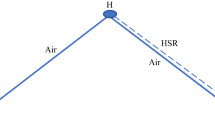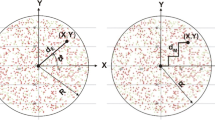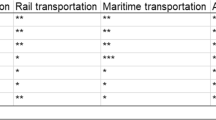Abstract
This paper investigates the competition between HSR and the incumbent with vertical service differentiation for Indian corridors. As Indian government plans to invest in this new technology, strategic decisions pertaining to type of corridor, speed of HSR, HSR technology, given the competition scenario on that corridor becomes vital. The strategic interactions between the operators are modelled as a three staged game between the entrant and the incumbent considering the competition over fare and frequency to maximize different objective functions i.e. Profit and Social Welfare. Speed of HSR is taken as a strategic variable in the game with two levels of high speed, {Low-H, High-H}. This model is applied on two corridors of India of different length i.e. Bangalore-Delhi (competition with airlines with length of corridor being 2400 km) and Bangalore-Mysore (competition with bus with length of corridor being 150 km). Revealed and stated preference surveys are conducted for the passengers traveling on these corridors and a discrete choice model was estimated for both the corridors. These models were used to determine the modal share in the new hypothetical scenario which were in turn used in defining objective functions such as profits and social welfare. Various game scenarios characterized by sunk and variable cost of the modes are formulated and equilibrium for all demand levels is computed for both the corridors for these different objective functions. Results demonstrates variation in Nash equilibrium for different game scenarios and hence indicates the importance of incorporating speed as a strategic variable. Changing the objective function to social welfare maximization results in different equilibrium solution for Bangalore-Delhi corridor. Thus, impact of different combinations of demand, cost structures and objective functions are explored on the market equilibrium thereby providing interesting insights in this area.

Similar content being viewed by others
References
Adler N, Pels E, Nash C (2010) High-speed rail and air transport competition: game engineering as tool for cost-benefit analysis. Transp Res B 44(7):812–833
Ben-Akiva ME, Lerman SR (1985) Discrete choice analysis: theory and application to travel demand. MIT Press, Massachusetts
Ben-Akiva ME & Morikawa T (1990) Estimation of travel demand models from multiple data sources. Proceedings 11th International Symposium on Transportation and Traffic Theory, Yokohama
Bierlaire M, Axhausen K and Abbay G (2001) Acceptance of model innovation: the case of the Swissmetro. Proceedings of the 1st Swiss Transport Research Conference
Campos, J., & de Rus, G., 2009. Some stylized facts about high-speed rail: a review of HSR experiences around the world. Transp Policy, 16, 19–28
D’Alfonso T, Jiang C, Bracaglia V (2015) Would competition between air transport and high-speed rail benefit environment and social welfare? Transp Res B Methodol 74:118–137
De Rus G, Nombela G (2007) Is investment in high-speed rail socially profitable? J Transp Econ Pol 41(1):3–23
Friesz TL, Gottfried JA, Morlok EK (1986) A sequential shipper-carrier network model for predicting freight flows. Transp Sci 20(2):80–91
Friesz TL, Mookherjee R, Holguin-Veras J, Rigdon M (2008) Dynamic pricing in an urban freight environment. Transp Res B Methodol 42:305–324
Fu X, Zhang A, Lei Z (2012) Will China’s airline industry survive the entry of high-speed rail? Res Transp Econ 35:13–25
González-Savignat M (2004) Competition in air transport: the case of the high-speed train. J Transp Econ Pol 38(1):77–107
Harker PT, Friesz TL (1986a) Prediction of intercity freight flows, I: theory. Transp Res B Methodol 20(2):139–153
Harker PT, Friesz TL (1986b) Prediction of intercity freight flows, II: mathematical formulations. Transp Res B Methodol 20(2):155–174
Janic M (1993) A model of competition between high-speed rail and air transport. Transp Plan Technol 17(1):1–23
Jiang C, Zhang A (2014) Effects of high-speed rail and airline cooperation under hub airport capacity constraint. Transp Res B 60:33–49
Louviere JJ, Hensher DA and Swait JF (2000) Stated choice methods and analysis, Cambridge University Press, Cambridge
Mcfadden D (1974) Conditional logit analysis of qualitative choice behavior, frontiers in econometrics 105–142, New York: Academic Press
Osbourne MJ (2003) An introduction to game theory. Oxford University Press, Toronto
Priyadharshini J. and Selladurai M., 2016. A study on high speed rails in India. Int J Trend Res Dev 3(3) ISSN:2394–9333
Raturi V, Srinivasan K, Narulkar G, Chandrashekharaiah A and Gupta A (2013) Analyzing intermodal competition between high-speed rail and conventional transport systems: A game theoretic approach, 2nd Conference of Transportation Research Group of India, Procedia - Social and Behavioral Sciences, Vol. 104, pp. 904-913.
Roman C, Martin JC (2014) Integration of HSR and air transport: understanding passengers’ preferences. Transp Res E-Log 71:129–141
Roman C, Espino R, Martin JC (2007) Competition of high-speed train with air transport: the case of Madrid–Barcelona. J Air Transp Manag 13(5):277–284
Rothengatter W (2011) Competition between airlines and high-speed rail. In: Macario R, van de Voorde E (eds) Critical issues in air transport economics and business. Routledge, Oxford
Shyr OFY, Hung MF (2010) Intermodal competition with high-speed rail-a game theory approach. J Mar Sci Technol 18(1):32–40
Small KA, Rosen HS (1981) Applied welfare economics with discrete choice models. Econometrica 49:105–129
Train K (2003) Discrete choice methods with simulation. Cambridge University Press, Cambridge
Verma A and Raturi V (2016) Analyzing Intercity Modal Choice and Competition Between High Speed Rail (HSR) and Other Transport Modes in Indian Context , Handbook of Research on Emerging Innovations in Rail Transportation Engineering, Chapter-7 pp. 146–160
Vision 2020 Board. Government of India - New Delhi: Vision 2020 (2009). In Indian Railways. Retrieved June 29, 2013, from http://www.nwr.indianrailways.gov.in/uploads/files/1299058054467-englishvision.pdf
Wang JY, Yang H (2005) A game-theoretic analysis of competition in a deregulated bus market. Transp Res E-Log 41(4):329–355
Xiao F, Yang H (2007) Three-player game-theoretic model over a freight transport network. Transp Res C 15:209–217
Yang H, Zhang A (2012) Effects of high-speed rail and air transport competition on prices, profits and welfare. Transp Res B Methodol 46(10):1322–1333
Yang H, Kong HK, Meng Q (2001) Value-of-time distributions and competitive bus services. Transp Res E 37:411–424
Zhang B, Yao T, Friesz TL and Hongcheng L (2012) Urban Freight Transportation Planning: A Dynamic Stackelberg Game-Theoretic Approach, DTA: 4th International Symposium on Dynamic Traffic Assignment, Martha’s Vineyard, Massachusetts
Acknowledgements
The authors wish to thank Kempegowda International Airport Bengaluru (KIAB) and Indian Railways south west department, for granting permission to conduct surveys at Kempegowda International airport and Bengaluru city junction respectively.
Author information
Authors and Affiliations
Corresponding author
Rights and permissions
About this article
Cite this article
Raturi, V., Verma, A. Competition between High Speed Rail and Conventional Transport Modes: Market Entry Game Analysis on Indian Corridors. Netw Spat Econ 19, 763–790 (2019). https://doi.org/10.1007/s11067-018-9421-2
Published:
Issue Date:
DOI: https://doi.org/10.1007/s11067-018-9421-2




